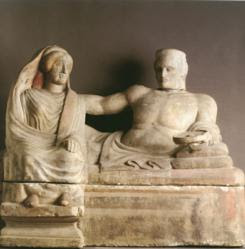[INFO]
Pre-Roman art of ancient Italy will amaze viewers during an exclusive presentation of The Etruscans: An Ancient Italian Civilization. Beginning June 10, 2011 and running through September 25, the National Geographic Museum in Washington, D.C. will be the proud home to the unique art and artifacts of ancient Italy.

Cinerary Urn, Città della Pieve (Perugia), First half IV century BCE The exhibition will be a highlight of La Dolce DC, a celebration of Washington’s Italian connections, and of ITALY@150, a series of events organized by the Embassy of Italy under the auspices of the President of the Italian Republic to celebrate the 150th Anniversary of Italy’s Unity.
The Etruscans artistry will be on full display, featuring more than 450 original artifacts from Florence and Chiusi, tracing the development of this unique civilization from its ninth-century BCE origins to its dominant position on the Italian peninsula. The wealth of objects found in archaeological sites throughout Tuscany and its neighboring provinces continues to testify to the brilliance and influence of this ancient people.
Skillful seafarers, wealthy merchants and expert metallurgists, the Etruscans dominated the cultural and economic life of the Italian peninsula for centuries before the rise of the Roman Republic in 510 BCE. The ancient Etruscans have long captivated the public imagination through their beliefs, scientific accomplishments and their artistic mastery – information gathered from their remarkable legacy of lavish burial gifts, domestic implements, tools and weaponry, jewelry, expertly executed sculptures and wall paintings.
This distinctive collection includes rare artifacts on loan from the Museo Archeologico Nazionale, Florence, and the rarely-seen Collezione Cambi, Chiusi. They include a 7th-century BCE carriage found in the Tomb of Carriages at the Necropolis of San Carbone, Populonia; a late 6th-century BCE clay amphora from Argilla; a 4th-century BCE three-foot high alabaster urn from Perugia; a 4th-century BCE gold diadem; and a late 2nd-century BCE terracotta sarcophagus.
International arts and exhibitions purveyors Exhibits Development Group and Cotemporanea Progetti have combined forces to bring this exciting venture to the National Geographic Museum.
Exhibits Development Group, headquartered in St. Paul, Minnesota, is committed to initiating and promoting international cultural and intellectual exchange by bringing high-quality traveling exhibitions of art, science, and history to a broad and diverse audience.
Contemporanea Progetti of Florence is a service company specializing in the organization and production of temporary exhibitions featuring Italy’s artistic heritage for audiences both at home and abroad.
[/INFO]
Pre-Roman art of ancient Italy will amaze viewers during an exclusive presentation of The Etruscans: An Ancient Italian Civilization. Beginning June 10, 2011 and running through September 25, the National Geographic Museum in Washington, D.C. will be the proud home to the unique art and artifacts of ancient Italy.

Cinerary Urn, Città della Pieve (Perugia), First half IV century BCE The exhibition will be a highlight of La Dolce DC, a celebration of Washington’s Italian connections, and of ITALY@150, a series of events organized by the Embassy of Italy under the auspices of the President of the Italian Republic to celebrate the 150th Anniversary of Italy’s Unity.
The Etruscans artistry will be on full display, featuring more than 450 original artifacts from Florence and Chiusi, tracing the development of this unique civilization from its ninth-century BCE origins to its dominant position on the Italian peninsula. The wealth of objects found in archaeological sites throughout Tuscany and its neighboring provinces continues to testify to the brilliance and influence of this ancient people.
Skillful seafarers, wealthy merchants and expert metallurgists, the Etruscans dominated the cultural and economic life of the Italian peninsula for centuries before the rise of the Roman Republic in 510 BCE. The ancient Etruscans have long captivated the public imagination through their beliefs, scientific accomplishments and their artistic mastery – information gathered from their remarkable legacy of lavish burial gifts, domestic implements, tools and weaponry, jewelry, expertly executed sculptures and wall paintings.
This distinctive collection includes rare artifacts on loan from the Museo Archeologico Nazionale, Florence, and the rarely-seen Collezione Cambi, Chiusi. They include a 7th-century BCE carriage found in the Tomb of Carriages at the Necropolis of San Carbone, Populonia; a late 6th-century BCE clay amphora from Argilla; a 4th-century BCE three-foot high alabaster urn from Perugia; a 4th-century BCE gold diadem; and a late 2nd-century BCE terracotta sarcophagus.
International arts and exhibitions purveyors Exhibits Development Group and Cotemporanea Progetti have combined forces to bring this exciting venture to the National Geographic Museum.
Exhibits Development Group, headquartered in St. Paul, Minnesota, is committed to initiating and promoting international cultural and intellectual exchange by bringing high-quality traveling exhibitions of art, science, and history to a broad and diverse audience.
Contemporanea Progetti of Florence is a service company specializing in the organization and production of temporary exhibitions featuring Italy’s artistic heritage for audiences both at home and abroad.
[/INFO]

